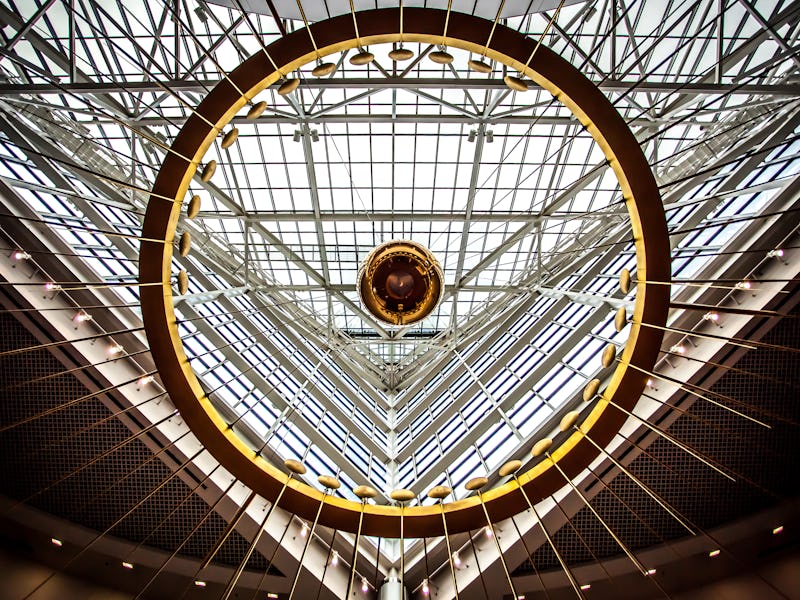The 5 Most Beautiful Scientific Demonstrations of All Time
Beauty is truth, truth is beauty.

If beauty is in the eye of the beholder, it’s fair to say the general public has rendered science plain. The accumulation of data in controlled situations isn’t, after all, loveliness embodied. But an experiment can be beautiful, especially when it transforms into a demonstration. There’s something to be said for watching truth transpire.
In Frank Wilczer’s book Finding Nature’s Deep Design, the Nobel Prize winner in physics argues that science proves that the world “embodies beautiful ideas,” placing nature into the “context of spiritual cosmology.” But, regardless of whether the beauty underlying science really does prove anything spiritual, it’s undeniable that scientists are capable of arranging their instruments in ways that seem profound.
Here are seven of those setups, each is as lovely as it is perfectly calibrated.
Foucault’s Pendulum
In 1851, French physicist Leon Foucault went to the Parisian Pantheon and suspended a 67 meter, 28 kilogram pendulum from the dome. As he set it swinging, Foucault provided a deceptively simple demonstration of how the Earth moves — rotating and clockwise.
The Foucault pendulum at the Griffith Observatory in Los Angeles.
Today, Foucault pendulums can be found all over the world but it’s only at the Earth’s poles where the pendulum swings in fixed respect to the stars while the planet rotates below. At every other location, the plane of the pendulum moves in respect to Earth’s inertial frame. Still, Foucault’s Pendulum illustrates the fact that every point of the universe is at a fixed point. If you hang a pendulum, and are careful that nothing affects its movement other than gravity, you can see evidence of Earth’s rotation pushed by the Coriolis force, the same force that is responsible for weather patterns and ocean currents.
The Rainbow
More specifically, light shined through a glass prism, creating a rainbow. Or alternatively, a kaleidoscope. Both of these situations illustrate the scientific principle that white light is a combination of all the visible colors of a rainbow.
A recreation of Newton's experiment.
Sir Isaac Newton declared that “light itself is a heterogenous mixture of differently refrangible rays” during his late 1600’s prism experiments. While England got ransacked by the Plague, Newton experimented with light refraction and dispersion by setting a glass prism in front of a light beam, shot out through a hole in a window shade. His set of experiments with prisms are what led to the discovery of the color spectrum derived by nature and an integral moment within the science of optics.
The Music of the Spheres
The ancient Greek philosopher Pythagoras was obsessed with math — so obsessed that he actually formed the Order of the Pythagoreans, which was essentially a cult dedicated to math and its connection to the Earth. One of the reasons math was so beautiful, believed Pythagoras, was that it could be connected to the harmonies produced by instrument: It was at its essence, the foundation of music.
A 1400's interpretation of Pythagoras' experiments.
By experimenting with stringed instruments, Pythagoras determined what’s considered one of the first qualitative laws of Nature: That the harmony of tones is connected to hidden relationships in numbers. He found that strumming strings in certain intervals could be expressed as the ratio of whole numbers — a process that also incorporated the physics concepts of frequency, consonance, and dissonance.
The Double Helix
The double helix is one of the most recognizable images in science and with good reason: The discovery of the molecular shape of a double-stranded DNA led to revolutionary insights regarding genetic code and protein synthesis. First illustrated in 1954 by Odile Crick and published in the one page paper “A Structure for Deoxyribose Nucleic Acid,” the double helix gave way to the first understanding of how genes control the chemical process within cells.
Francis Crick and James Watson, drawing heavily from the work of Rosalind Franklin, messed around with cardboard cut-outs of molecules until the realization hit that DNA strands bond and wind together, each with a backbone of deoxyribose and phosphate groups while attached at the base of each pairing is one of the four bases: adenine, cytosine, guanine, or thymine. They were dazzled at how simultaneously complex and simple the structure appeared to be.
Crystallization
Crystals are probably the prettiest embodiment of two natural processes categorized by science — ionic and covalent bonding. But let’s go back to what a crystal really is: Any solid material where component atoms are arranged in a definite pattern. The surface of the crystal reflects the material’s internal symmetry, causing the bulbous, sparkling appearance of crystals. A material becomes crystalline when its atoms are connected by ionic or covalent bonding, and the unit cells of a crystal connect themselves together to form visible shapes. Young scientists can buy proof in toy stores.
Only a few crystals are covalently bonded (like diamonds) and they are the strongest. This crystal formation process, long debated, was confirmed to be correct in 2013 by a team of American and German researchers.
Time lapse of a crystal forming.